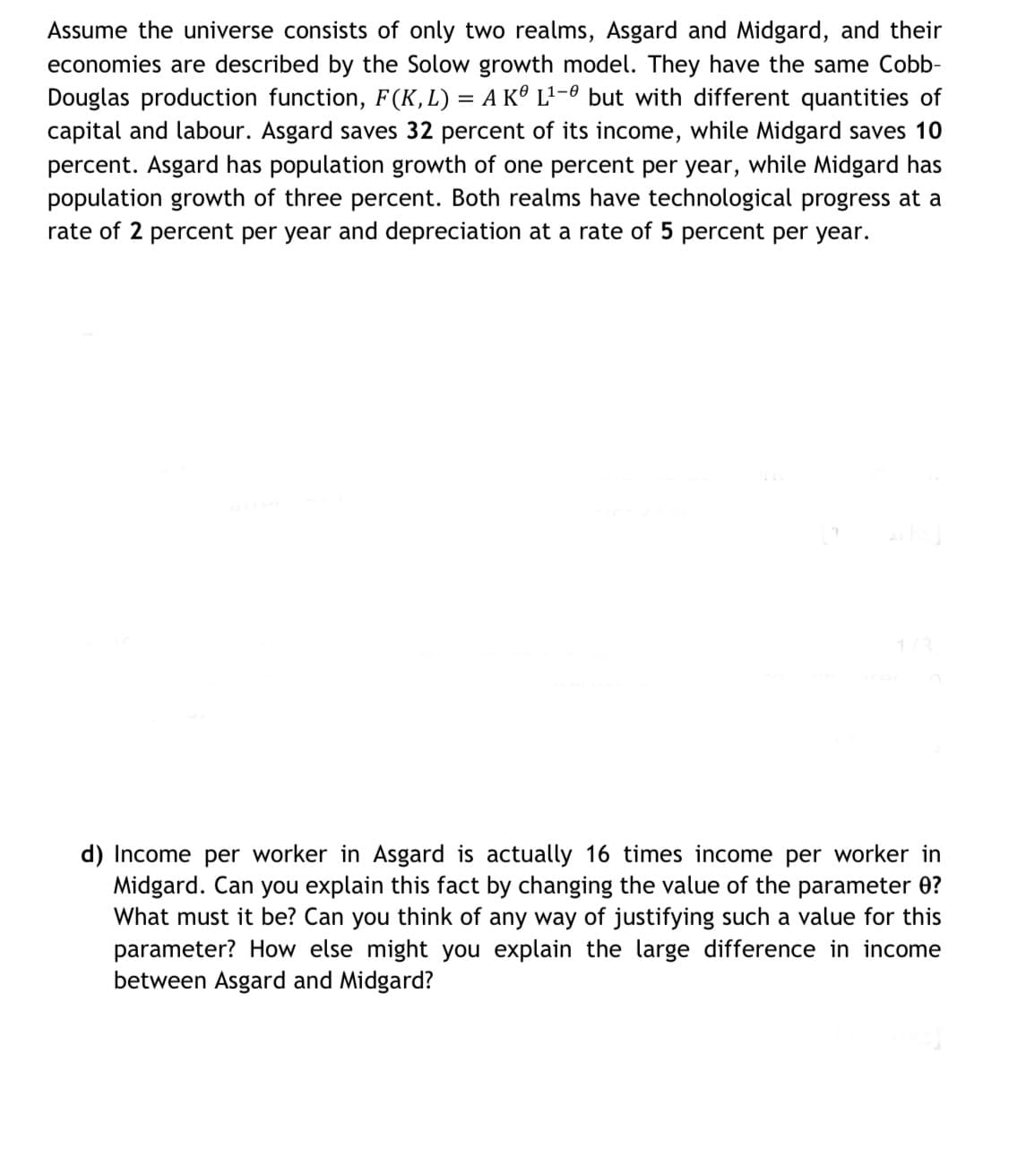Assume the universe consists of only two realms, Asgard and Midgard, and their economies are described by the Solow growth model. They have the same Cobb- Douglas production function, F(K, L) = A Kº L¹-0 but with different quantities of capital and labour. Asgard saves 32 percent of its income, while Midgard saves 10 percent. Asgard has population growth of one percent per year, while Midgard has population growth of three percent. Both realms have technological progress at a rate of 2 percent per year and depreciation at a rate of 5 percent per year.
Assume the universe consists of only two realms, Asgard and Midgard, and their economies are described by the Solow growth model. They have the same Cobb- Douglas production function, F(K, L) = A Kº L¹-0 but with different quantities of capital and labour. Asgard saves 32 percent of its income, while Midgard saves 10 percent. Asgard has population growth of one percent per year, while Midgard has population growth of three percent. Both realms have technological progress at a rate of 2 percent per year and depreciation at a rate of 5 percent per year.
Chapter1: Making Economics Decisions
Section: Chapter Questions
Problem 1QTC
Related questions
Question
Can you show me the solution for part d)

Transcribed Image Text:Assume the universe consists of only two realms, Asgard and Midgard, and their
economies are described by the Solow growth model. They have the same Cobb-
Douglas production function, F(K, L) = A Kº L¹-º but with different quantities of
capital and labour. Asgard saves 32 percent of its income, while Midgard saves 10
percent. Asgard has population growth of one percent per year, while Midgard has
population growth of three percent. Both realms have technological progress at a
rate of 2 percent per year and depreciation at a rate of 5 percent per year.
d) Income per worker in Asgard is actually 16 times income per worker in
Midgard. Can you explain this fact by changing the value of the parameter 0?
What must it be? Can you think of any way of justifying such a value for this
parameter? How else might you explain the large difference in income
between Asgard and Midgard?
Expert Solution
This question has been solved!
Explore an expertly crafted, step-by-step solution for a thorough understanding of key concepts.
This is a popular solution!
Trending now
This is a popular solution!
Step by step
Solved in 2 steps

Knowledge Booster
Learn more about
Need a deep-dive on the concept behind this application? Look no further. Learn more about this topic, economics and related others by exploring similar questions and additional content below.Recommended textbooks for you


Principles of Economics (12th Edition)
Economics
ISBN:
9780134078779
Author:
Karl E. Case, Ray C. Fair, Sharon E. Oster
Publisher:
PEARSON

Engineering Economy (17th Edition)
Economics
ISBN:
9780134870069
Author:
William G. Sullivan, Elin M. Wicks, C. Patrick Koelling
Publisher:
PEARSON


Principles of Economics (12th Edition)
Economics
ISBN:
9780134078779
Author:
Karl E. Case, Ray C. Fair, Sharon E. Oster
Publisher:
PEARSON

Engineering Economy (17th Edition)
Economics
ISBN:
9780134870069
Author:
William G. Sullivan, Elin M. Wicks, C. Patrick Koelling
Publisher:
PEARSON

Principles of Economics (MindTap Course List)
Economics
ISBN:
9781305585126
Author:
N. Gregory Mankiw
Publisher:
Cengage Learning

Managerial Economics: A Problem Solving Approach
Economics
ISBN:
9781337106665
Author:
Luke M. Froeb, Brian T. McCann, Michael R. Ward, Mike Shor
Publisher:
Cengage Learning

Managerial Economics & Business Strategy (Mcgraw-…
Economics
ISBN:
9781259290619
Author:
Michael Baye, Jeff Prince
Publisher:
McGraw-Hill Education